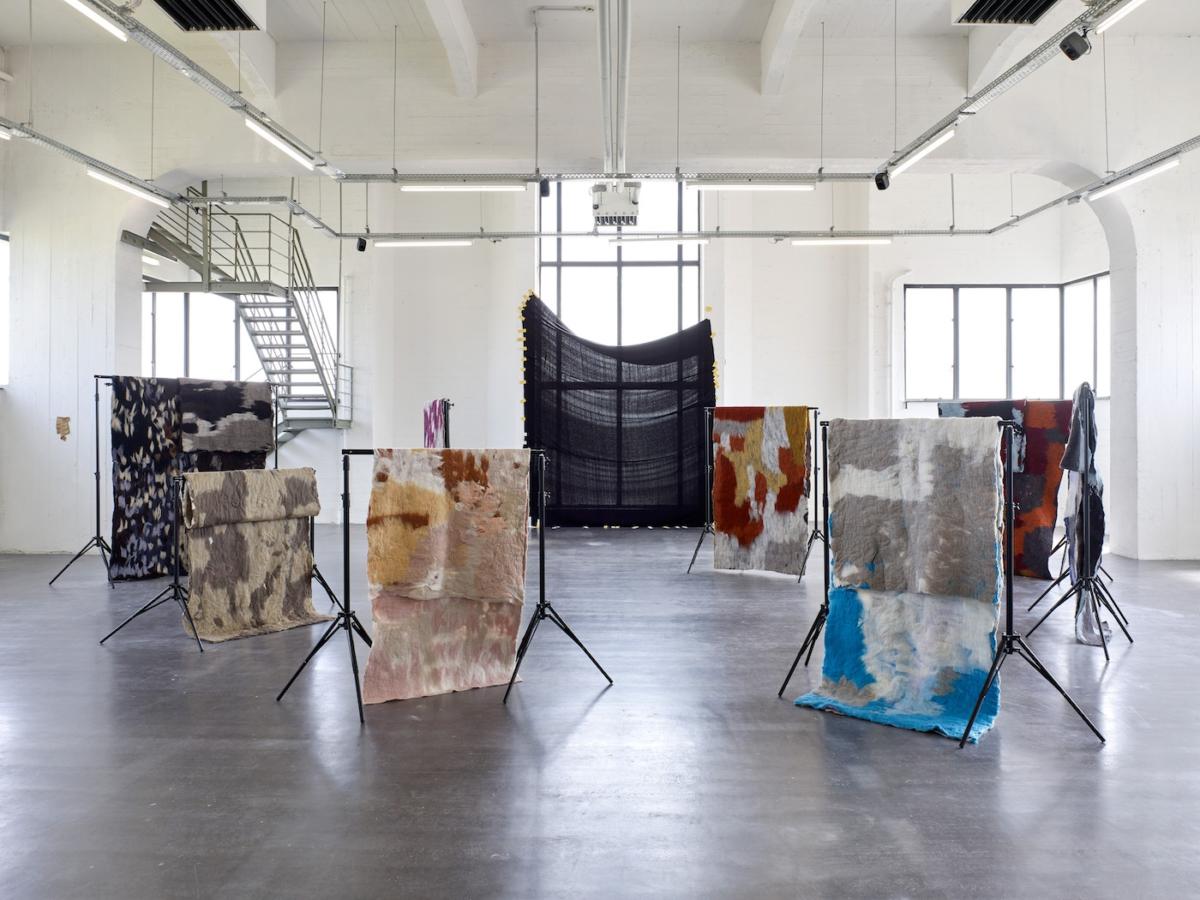
Her works are often made in collaboration or in dialogue with other artists and non-artists. For example, one recent work resulted from a series of workshops conducted over a year. The workshops explored the relation between language and craft and were conducted with a group of women in the community arts centre Globe Aroma in Brussels. This work, alongside other works by Miletić, were presented last year at WIELS Contemporary Art Centre in Brussels in the framework of Dependencies, the artist’s first major solo exhibition.
This interview was made one week before the opening of her solo show Materiale at gallery LambdaLambdaLambda in Prishtina, Kosovo. I met Hana on a misty morning at her studio in Uccle, uptown Brussels. Half of the space of her medium-size studio is occupied by a big loom, which produced some of her recent textile works. We spoke about the samples of work that hang on the walls of her studio and about her photographic background, which resurfaces in these textile works. When you zoom in, you can notice that through the grid of zeros and ones the patterns of the textiles resemble digital photographic images. But there are glitches, which come from the translation from one medium into another, which create skin-like folds. Her work testifies to the fact that contemporary art is and should be tactile. The objects that Miletić creates are almost asking to be caressed.
Romuald Demidenko: Your practice is often described as originating from the medium of street photography even though most of your works that I have seen are not photographs but rather textiles and text. Can you describe the topics you are currently working on?
Hana Miletić: I am currently preparing for my solo exhibition Materiale at LambdaLambdaLambda in Prishtina. The work I am going to present there will be based on photographs that I took in the streets. As a matter of fact, I studied Photography in art school, and before that Archeology and Art History. The photographs that I used to take, and still do, were made in a snapshot-like manner, very quickly. This came very easily to me, and because this process was so direct, I became very confused by what I was doing. My mind couldn’t catch up with my eyes, so to speak. On top of that, I struggled with the fact that reproduction in photography is a scientific process from which you are quite detached. After learning about the value of social reproduction, these two forms of reproduction, the reproduction I knew from photography and society, seemed miles apart. I think that due to that intractability my work became less and less photographic. This culminated in 2015 during the Young Belgian Art Prize exhibition in BOZAR, where I staged a series of poetry readings. While that was going on, the young hip-hop band La Frénétick, whose lyrics the poetry was based on, was making a record in the music studios of BOZAR. I was organizing and producing, or maybe even curating, the whole event. At that point, my work was almost immaterial and mainly conceptual.
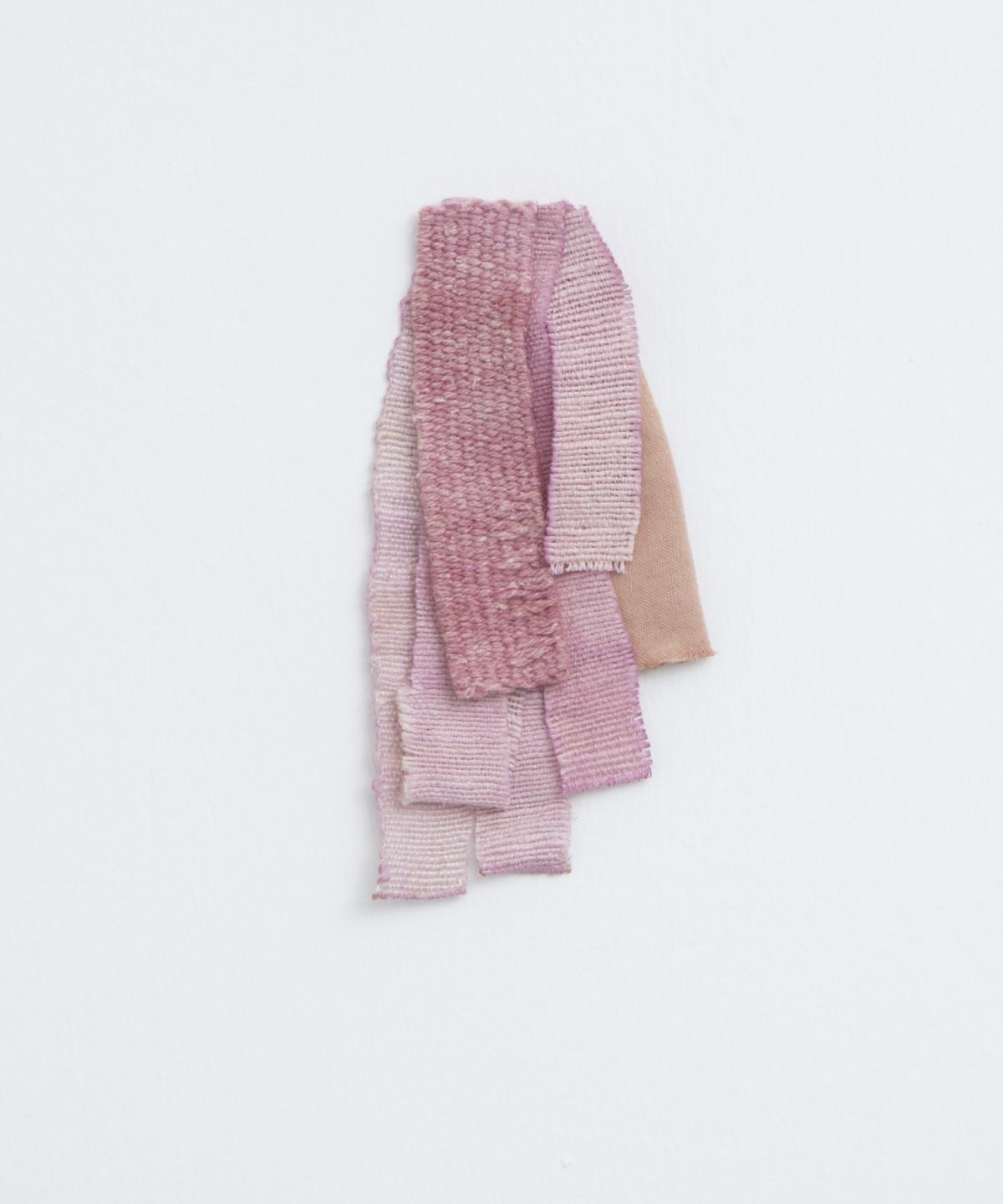
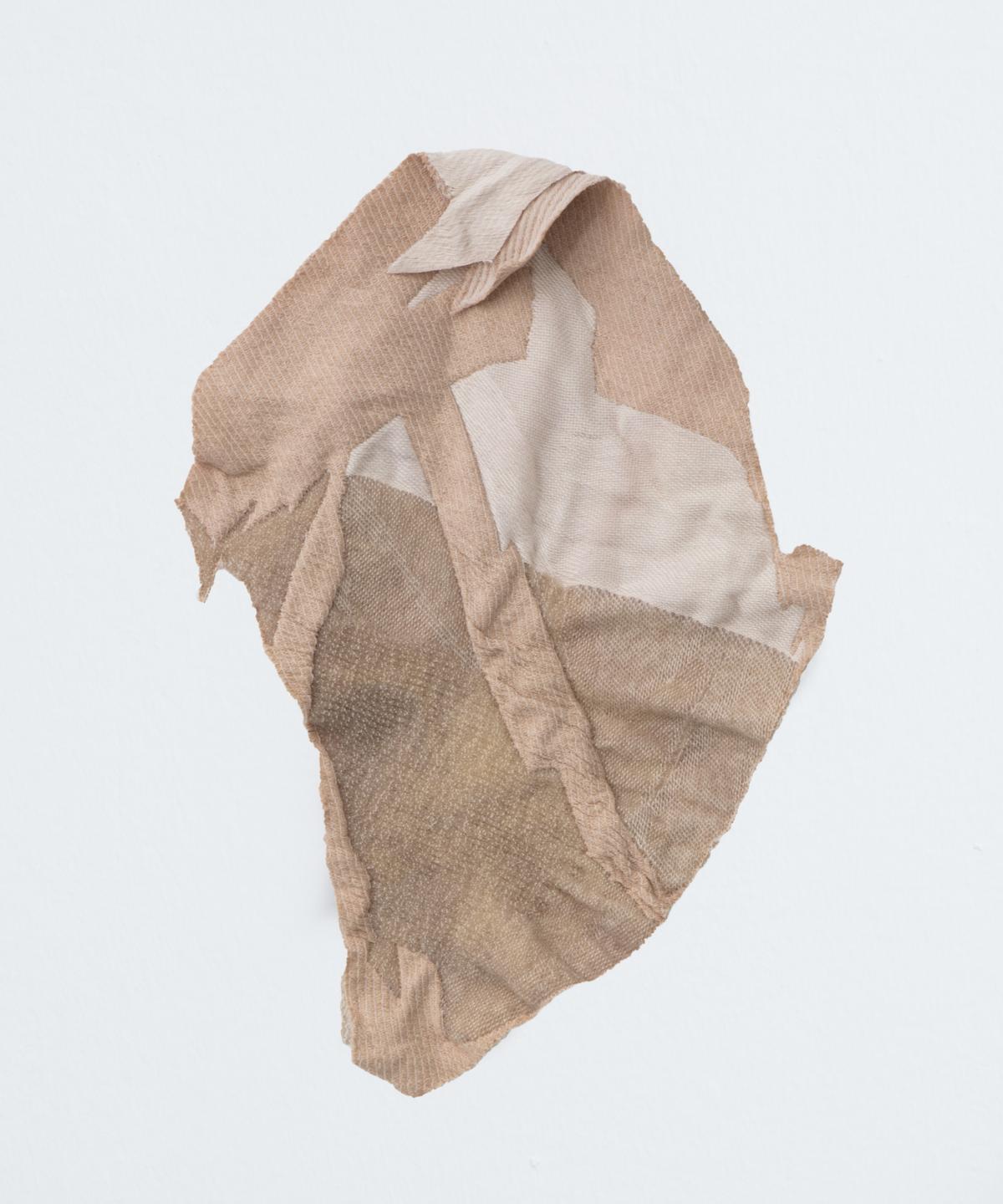

I struggled with that transition and developed the desire to touch materials again, to work less conceptually. And then, just by accident, I enrolled in a community weaving class in Brussels. These classes take place in a big, shared studio space where people from different generations make textiles. At some point, I started taking the photographs that I had taken on the streets with me to weaving class, and I started reproducing the forms and colours in the photographs. I was mainly photographing ephemeral materials in public space whose purposed was to protect buildings or to cover them. I had already gathered a small archive of these kinds of images. The materials in the images show certain transformations and scarcities, but they also document gestures of care. I got really interested in this multiplicity, because when looking at these images, you understand certain economical and social processes in the city.
As already mentioned, I started translating these images into woven structures. Weaving and (digital) photography share the same grid of binary zero’s and ones as their metadata or back end. Through weaving, I have learned that you can manipulate and stretch that grid. This is the moment when I understood that I could have access to reproduction in ways that I didn’t have before.
I developed the desire to touch materials again, to work less conceptually. And then, just by accident, I enrolled in a community weaving class in Brussels.
The preparations for your solo exhibition Dependencies in WIELS overlapped with the final stages of your participatory project at Globe Aroma, txt, Is Not Written Plain. Could you tell us more about that project?
Maybe it’s interesting to first explain what Globe Aroma is. Globe Aroma is a community arts centre for newcomers in Brussels. It is a place for people who want to engage in creative activities while spending time together. They do not necessarily have to have artistic ambition. The notion of who is a newcomer is taken in a broad sense, which creates a diverse social mix. Globe Aroma tries to create a network through which newcomers can get to know (fellow) artists and other art professionals, and in their spaces people can develop new skills or pick up their past practices – something that can be very challenging when arriving in a new place. Every year Globe Aroma invites an artist who has a more secure social position at the time of the invitation and has a background, or some affinity with what it means to be a newcomer. This artist is asked to devise a year-long project which allows people that use Global Aroma’s spaces to participate. In 2017 I was invited.
When I first visited Global Aroma I remarked that mainly men used the spaces. The participants were less diverse then I anticipated. This triggered me to make a program for women only. Also, I wanted to build a group that could work in the arts centre longer then the year-long project, and I wanted the arts centre to take gender diversity into account throughout all of their programming. These protocols were well received by Globe Aroma because I wanted to address the same issues that they had also faced, but hadn’t yet dealt with due to time constraints and the precarious nature of their work. Globe Aroma has an amazing community outreach, thanks to which we were able to form a core group of 15 women, almost all with different nationalities.
The work with that group of women during the year-long project at Globe Aroma was based on the overlap between language and textiles. What were your expectations at the start of the project?
I had this, in retrospect, ridiculous idea that we would write poetry together. This idea grew out of my own experience with language as a newcomer in the 1990s, when I was in a similar situation as the women I was working with. When you are an immigrant it is immediately clear to you that learning the language of the country you have arrived to is super important because this might grant you a residence and/or working permit. After that you have to use language on a daily basis to prove your existence in the new country. I really felt it was necessary to take down the notion of language as such, and to work with it differently with the women. At the end of the day, language is a sort of material, something that you can take and manipulate. So as a group we started to playfully work with language. From the start we were dealing with the vast number of approximately 18 languages – more languages than nationalities.
During these workshops the women learned about my love of textiles. At that time, I was already weaving for a few years, and I had just had a show in Beursschouwburg during which I presented to the public my first ever textile works. Also, it turned out that one of the women in our group, Salome Grdzelischvil, originally from Georgia, has an expertise in wool felting. This is Salome’s craft, which she was so generous to share with us. Salome taught the group how to work with wet felting, a very accessible process. Felt is the first man-made material. You just need soap, water and your hands to make plucks of wool bind together.
After a while we decided to intersect the writing sessions with the wool felting sessions. Our weekly meetings were always held around a big table on which we either wrote or felted, always together in group.

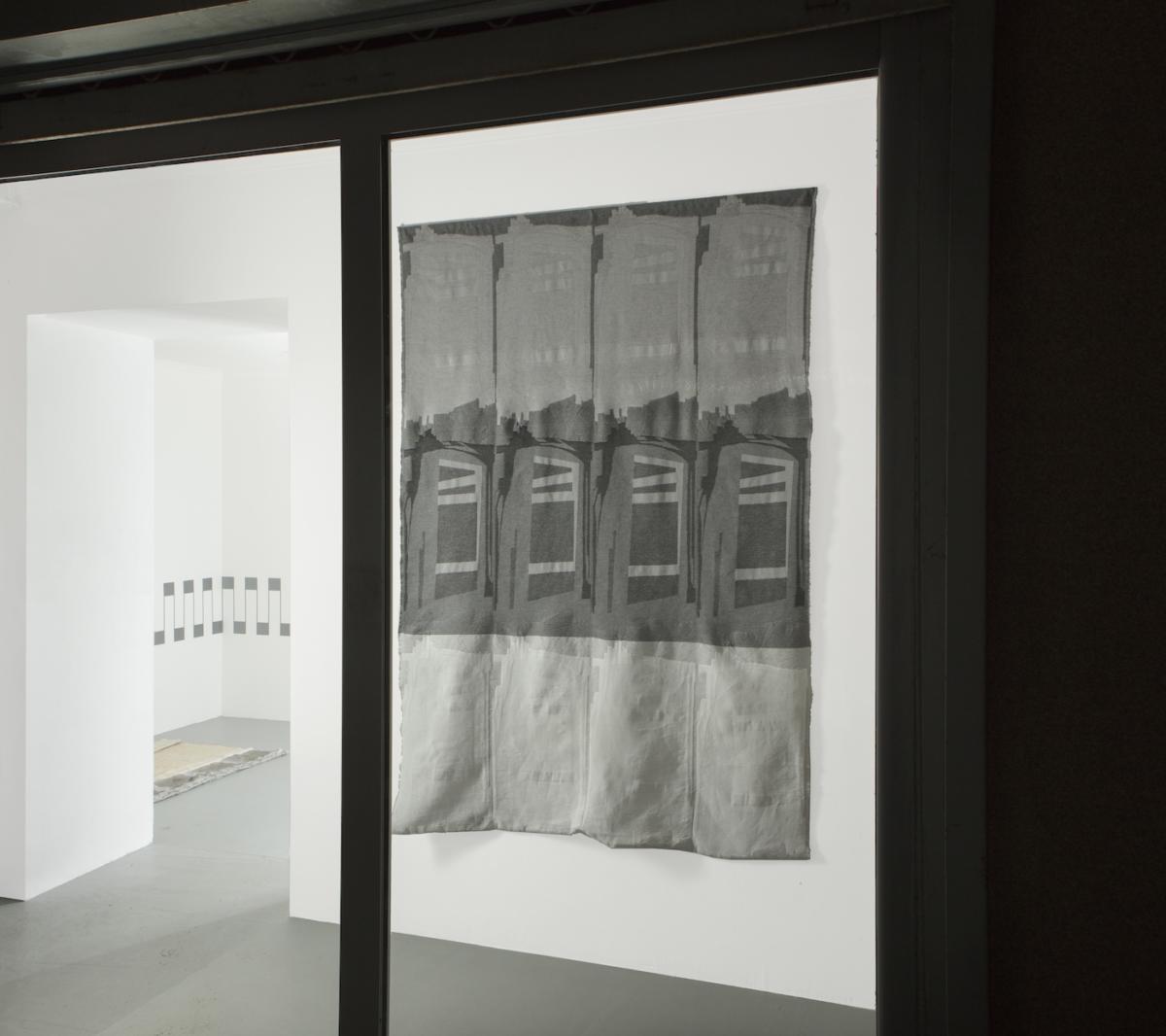
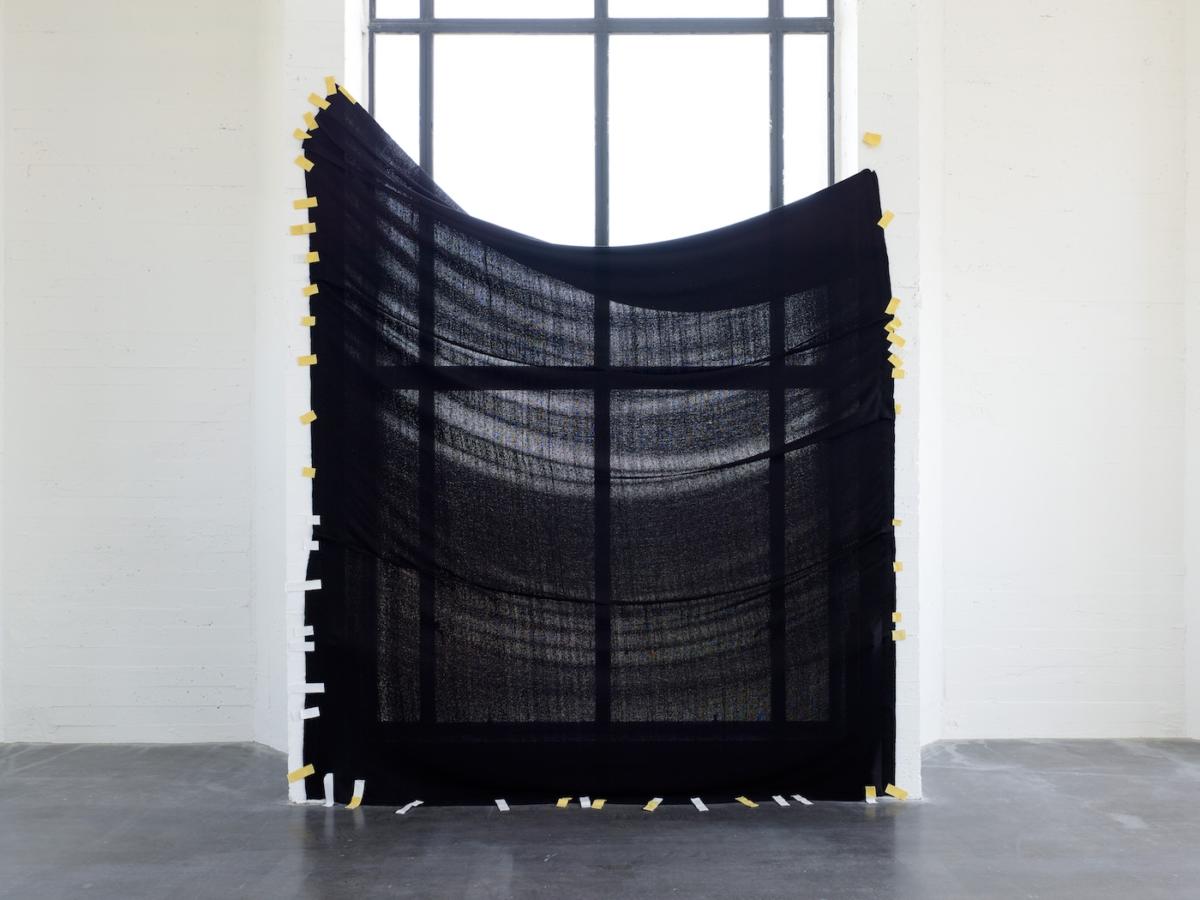

At some point, we started writing about the textiles that we were making. In the group we would make colour lists based on the felted pieces, and with these lists we would write poems in smaller groups or individually. To give an example, the poem Negro Is Not A Colour, written by Shilemeza Prins, was developed in this way. This poem was sparked by discussions that the group had about the word negro, and whether this word could be used to describe a colour. By focusing on the making process of the felt and the colours of the wool we worked with, we reflected on many things, like race or territory. At the end of the project we made an installation of twelve big pieces of felt accompanied by a sound piece, in which the women read their poems.
In my family there is a long tradition of working with textiles. My great grandmother was a also a weaver, but unfortunately she died when I was very young without passing on her skill.
I want to ask you about the photographic tripods on which the felts are draped, as they resemble the carpet hangers of the housing estates in Poland, where I grew up in late 1980s and early 90s.
I think I see what you mean: metal frames found outside, next to apartment blocks that people use to air and clean their carpets on, because the majority of Eastern Europeans live in apartments and don’t have private outdoor space like yards or gardens. This is not where the idea came from, but I know them well from the same kind of estates in Southeastern Europe where I grew up.
In studio photography these tripods are used to hang backdrops on while shooting portraits or still life images. When we started to build up the exhibition of our work in the spaces of Globe Aroma, where it was shown for the first time before going to WIELS and other exhibition spaces, it turned out that the exhibition room at Globe Aroma was not well insulated, unfortunately. We were dealing with roof leaks so we had to come up with an installation that was moveable, hence the use of tripods. I had tripods in my studio that I had kept from my photography practice. We tried draping the felts over them and this worked very well, so we decided to keep the tripods. Through the use of tripods the installation formally came closer to my more individual art practice.
In the press release for your solo show at WIELS the practice of handwork by women in your family during your childhood in Zagreb, former Yugoslavia is mentioned. Can you elaborate a bit on this experience and its influence on your current practice as presented in some of your recent exhibitions?
In my family there is a long tradition of working with textiles. My great grandmother was a also a weaver, but unfortunately she died when I was very young without passing on her skill. I remember that I learned a lot of different handwork techniques like crochet, knitting or embroidery as a kid with my grandmothers and my mother. This didn’t include weaving though. In my family’s photo album there is even a picture of my grandmother, my niece and myself plucking raw wool for further production, like felting. I guess that I kept the muscle memory of these handwork techniques, but I never imagined that they would one day become part of my art practice. When I started to weave, the gestures I learned immediately brought me back to these memories.
Weaving is done with a machine, the loom. Looms were initially operated by hand in households and smaller communities. With industrialisation, looms became automated and moved from homes to factories. The loom is not only the forerunner of a computer (hardware), but writing code (software) was also developed through the experience of weaving.
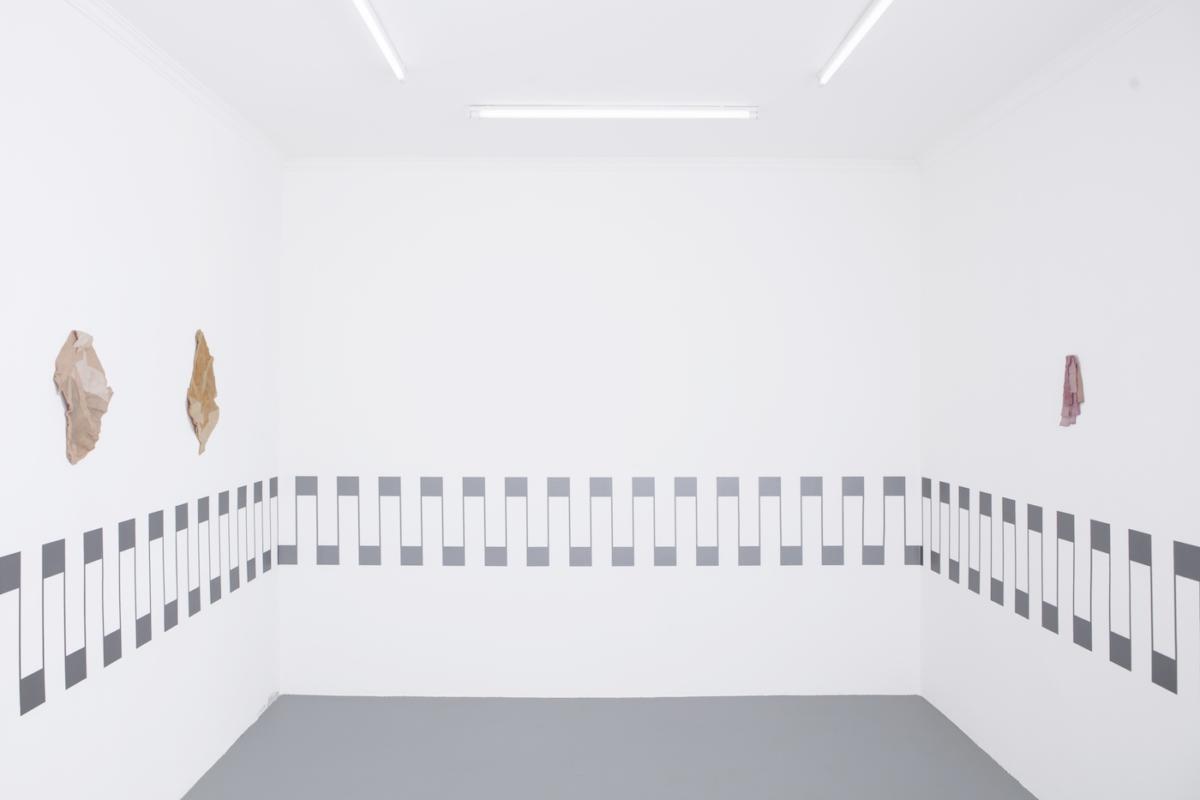
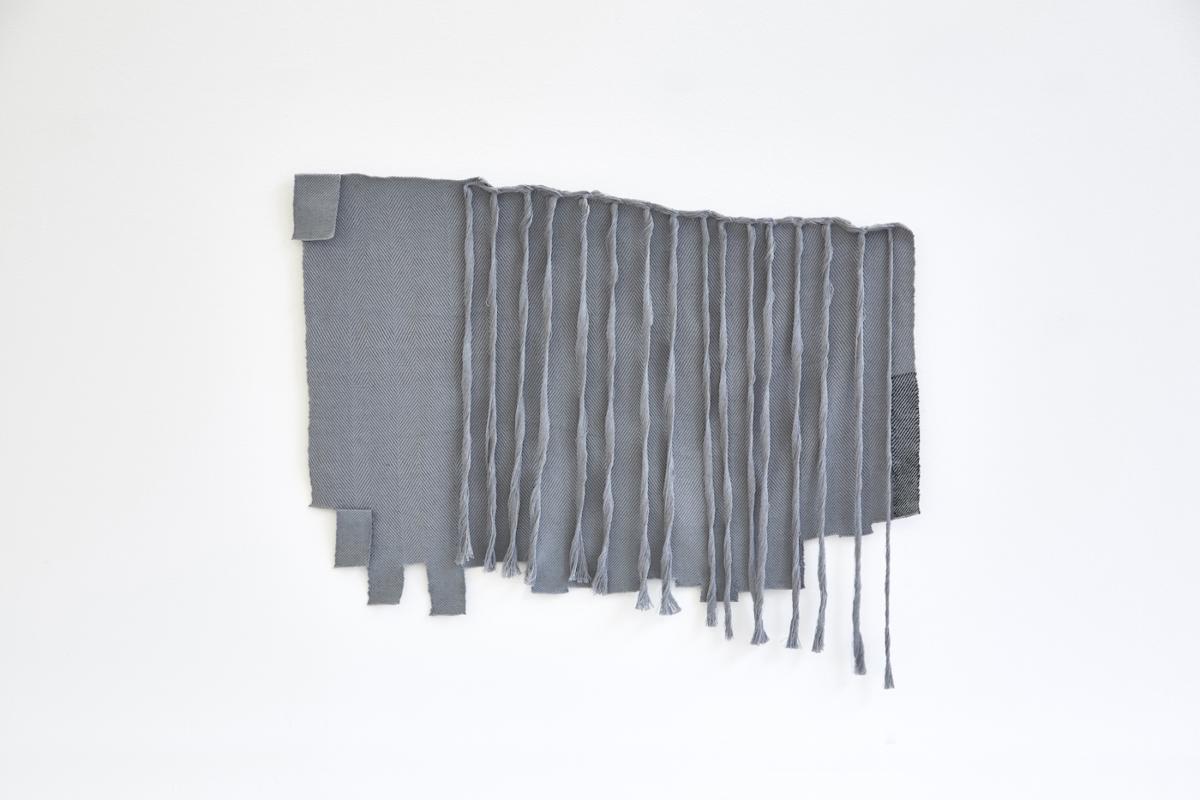

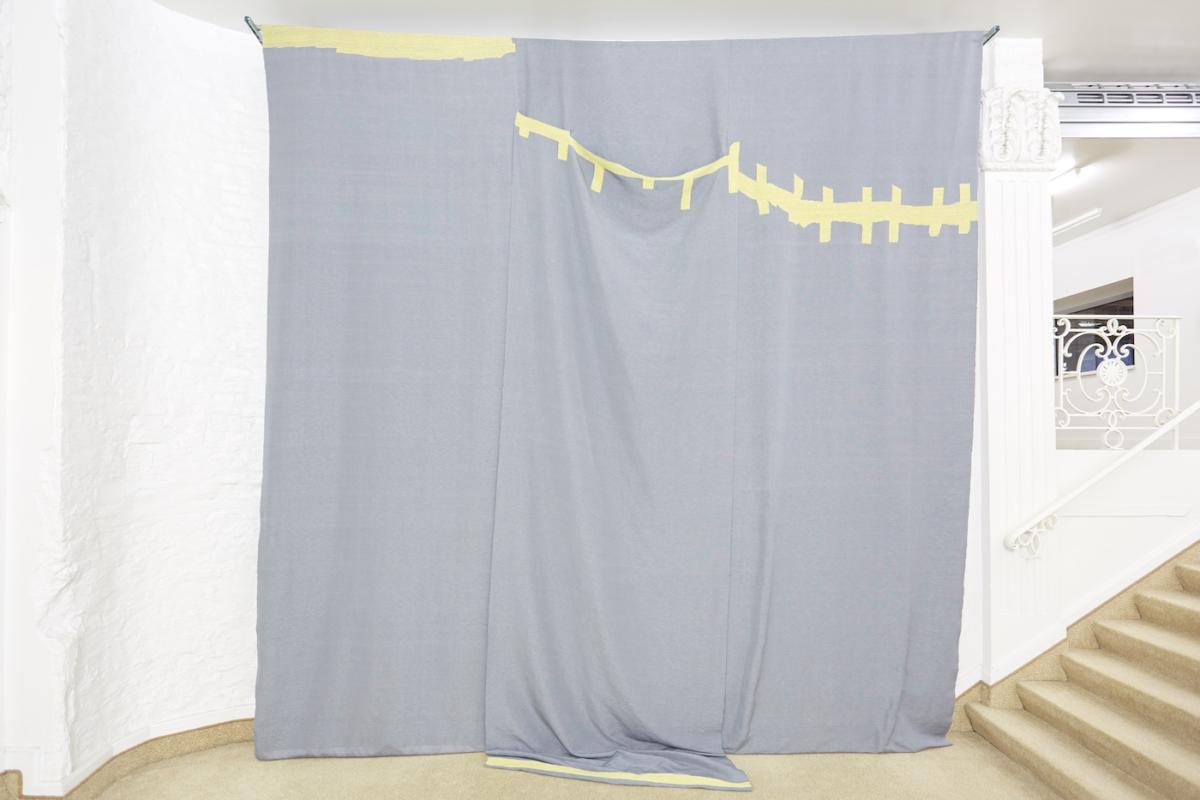
The text ‘The Future Looms, Weaving Women and Cybernetics’ by Sadie Plant traces these transformations of the loom through the organization of female labour. Plant recalls, amongst others, Ada Lovelace who was never credited fully for her developments as the assistant of Charles Babbage.
I understand weaving and the work on the loom as something that is strongly connected to technology. This is twofold, because besides being aware that one came from the other, I also think that textiles that were produced on a loom have a very specific tactility, very different than the touchability of devices like pads or phones that use same or similar technology. There’s an interesting glitch between what this hardware and software can produce. This is what I’m trying to introduce in the exhibition, Prishtina, when dealing with a combination of automation and handwork.
Can you tell me more about the most recent work presented in your upcoming exhibition at LambdaLambdaLambda?
To produce the works for this exhibition, of which the majority is brand new, I’ve used a mix of automated and manual weaving techniques. By doing so, I wanted to connect to a number of regional traditions. It will be my first time in Kosovo, but I have spent my childhood in a very similar part of Europe, where there is a comparable ethnographic tradition on the one hand, and on the other hand a more recent tradition of textile industry, and its painfully swift decline. In the region of former Yugoslavia, after the civil wars, almost all textile factories were privatized and closed. The close downs resulted in many people, mostly women in their 40s and 50 years of age, loosing their jobs, left with little opportunities on the job market. By using automation and handwork to produce my new works I want to bridge these traditions in space and time.
Materiale, which is a title of your show in Prishtina, speaks of your method of working and of the weaving process.
Yes, I often use a printout of the photograph that I want to weave while working on the loom. This method resembles the traditional method of making tapestries, with sketches or cartoons that were placed behind the looms and weaving frames. When I work with an automated or Jacquard loom, I translate the pixels of the photographic image into binds of horizontal and vertical threads. This is a different way of approaching reproduction. Here it doesn’t happen by hand but it is transmitted through coding. The Jacquard loom that I use has a funny function. It repeats an image, or a rapport in more technical terms, four times next to each other because this loom was built to weave patterned fabrics in an economical and efficient way. It was mainly used to produce textiles for households, like curtains, in the 1960s and 70s. I appropriated the form of this repeated rapport to produce woven works that look a bit like photographic contact sheets in which a negative is printed multiple times.
These recent works depict repeated and automated images but also show irregularities. While the textiles are being woven I pull at them in order to distort the normative logic of the grid and to stress the importance of the body in the automated production process.
I also want to ask you about the spatial work that you presented last year in a centrally located public square in Brussels, Place de la Monnaie/Muntplein. The pavilion-like structure with its characteristic grey and white checkerboard looked like an intriguing object. Quite often I visit the library on that same square, Muntpunt, to work there with my laptop, so I got to see some of the projects that were part of the festival almost by accident.
The pavilion you are mentioning was presented as part of the project Precarious Pavilion conceived by Michiel Vandevelde, which tries to re-imagine public spaces in different cities. The edition in Brussels, entitled The New Local, was curated by Lietje Bauwens and Wouter De Raeve, and – as you mentioned – took place in the centrally located square of La Monnaie or De Munt. Lietje, Michiel and Wouter wanted to research how this square could be used differently. They were not necessarily interested in putting physical things on the square because that is what the city does all of the time through various city branding projects. During the day different things happened on the square without being announced, hence why you discovered them by accident.
The title of the overarching project, Precarious Pavilion, intrigued me, and I actually really wanted to put something physical on the square, despite the different invitation. The title inspired me to create an actual pavilion, with walls made out of porous fabric, and a structure that is temporary, mobile and light.
The square as a location is very interesting. It is formed by strong markers such as the newly renovated shopping centre called The Mint, the city’s central administrative centre and the opera building. This square is delineated by institutions that project legality and/or trigger consumerism, while the square itself is a vast open space, a blank canvas for city marketers.
In my exhibition in WIELS, I showed the same grey and white checkerboard pattern in a installation that filled the room. The pattern could be seen in relation to the Blomme building’s modernist floor tiles. The pattern references at once Photoshop’s transparency grid but at the same time a weaving draft. It renders visible, but also supports the (re)production of images through the means of photography and weaving, the two media that I work with. After making that installation I wanted to take that grid off the wall and weave it as fabric. I wove the textile for the pavilion on the already mentioned automated Jacquard loom, which is considered to be a precursor to the first computer and acknowledged as an indispensable tool in the development of early software. In order to distort the binary and serial aesthetic of the grid this time I didn’t pull at the fabric during production, but I decided to produce a partly unbound fabric.
When an institution invites you for an exhibition there are certain expectations of how you should behave at the institution. I guess that at Beursschouwburg I was trying to use the institution a bit differently than what I was invited for.
I guess that I was looking how to make a space that is at the same time also an image, and how to make a fabric that is translucent but still can be protective in a way. There are many things that I think fabric can do while acting as a wall – I think. I wanted to use these pliable walls to create a temporary space within an existing space. When I made that space I wanted to activate it so I invited the group of women that I had worked with at Globe Aroma to the pavilion. After our felting and writing workshops the women wanted to keep doing things together so they initiated a group that meets on a regular basis – I think that this is the most beautiful thing that grew out of our project. One of the things that the women do during their meetings is that they make music together. I invited them to activate the pavilion by performing singing exercise inside of the space.
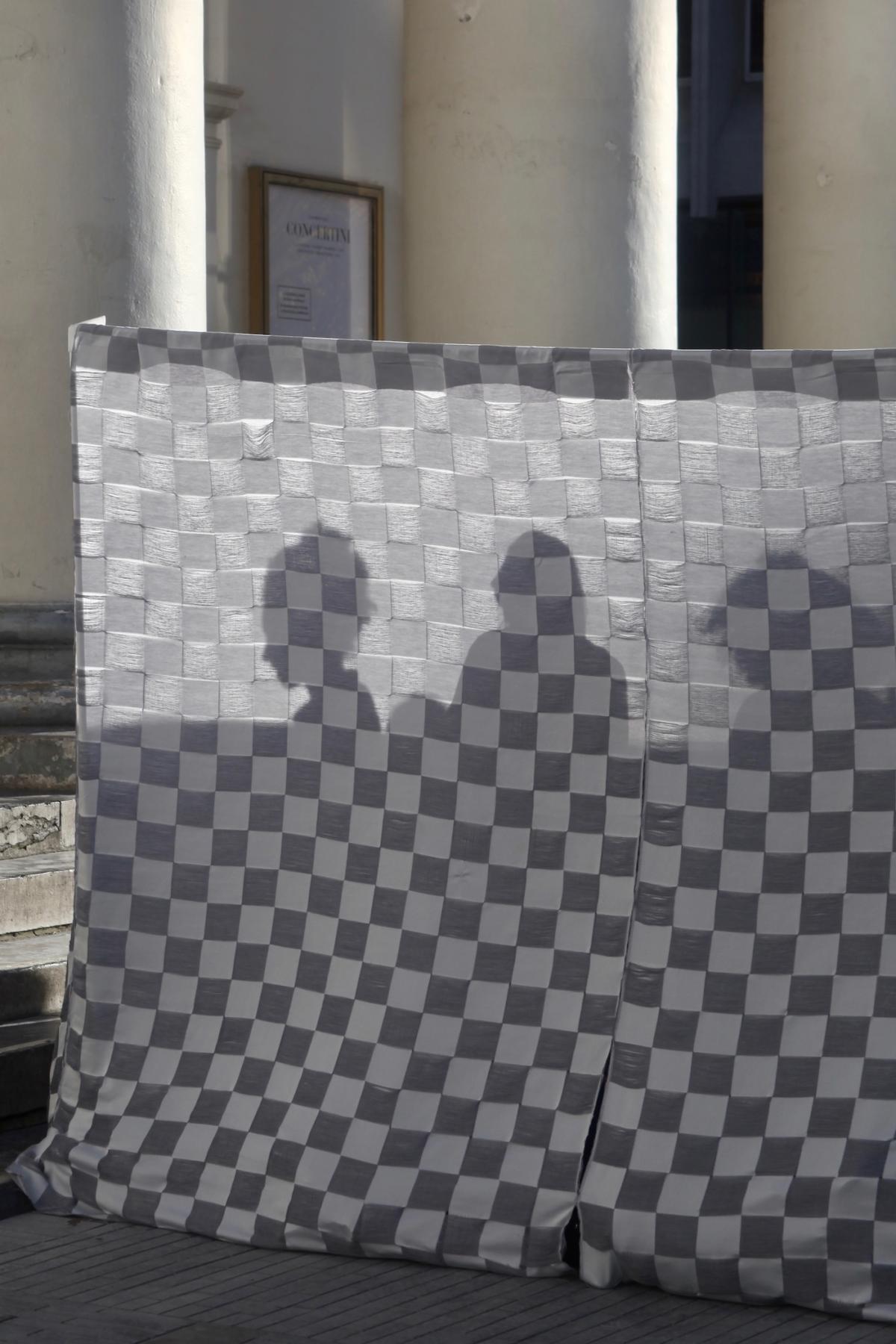
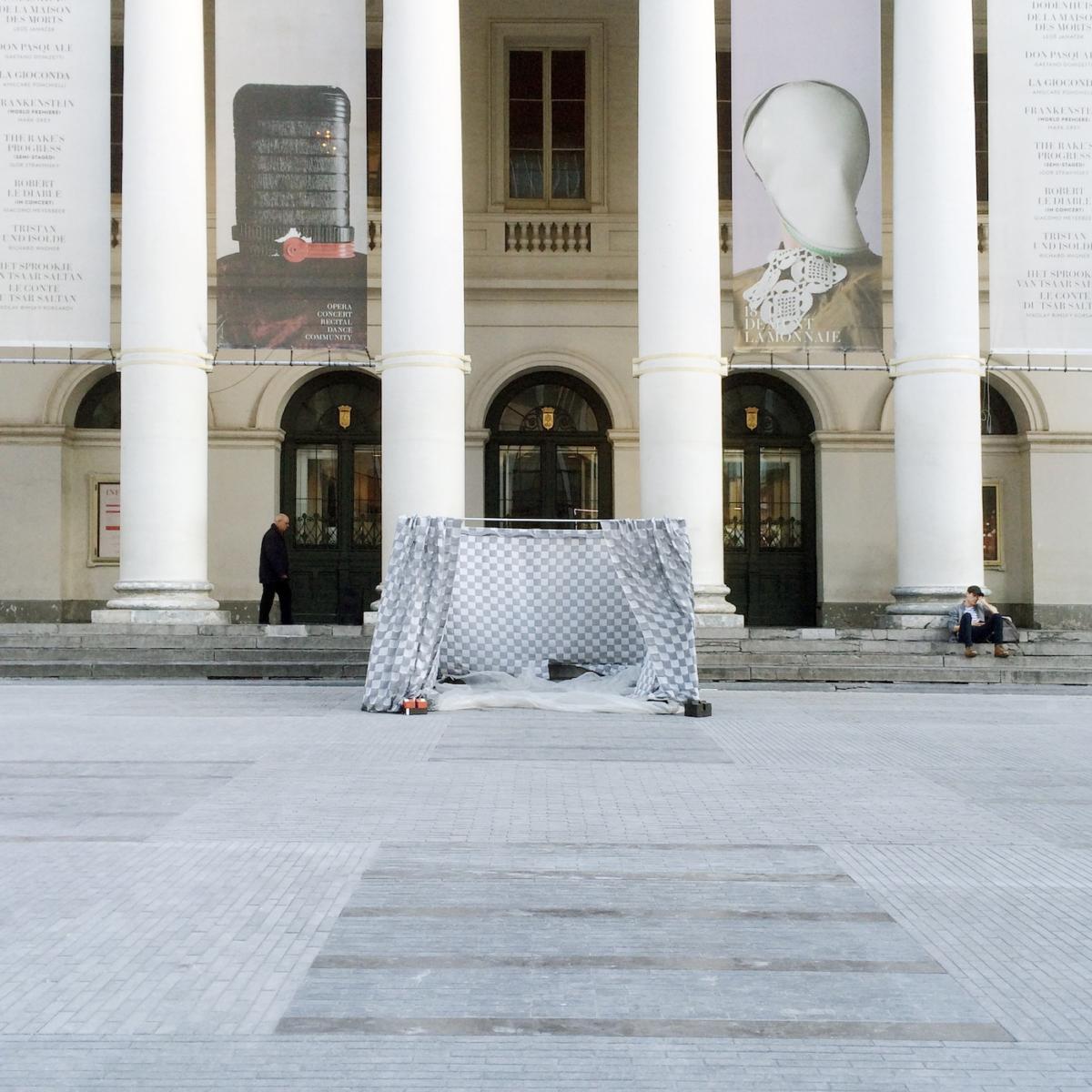
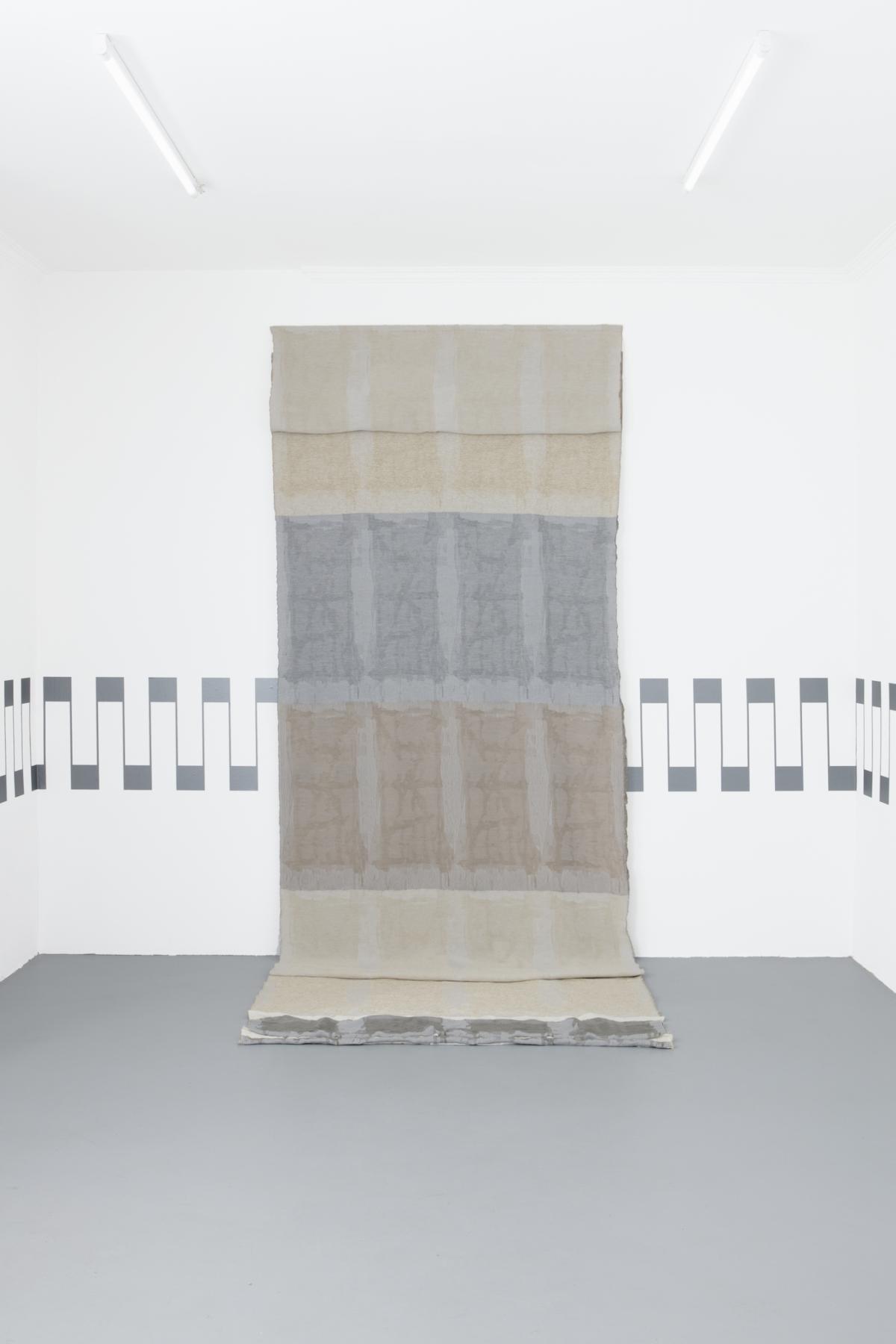
My first experience with your work happened shortly after I moved to Brussels in 2016, during your solo exhibition Materials at Beursschouwburg Brussels, a Flemish institution dedicated to music, performative and visual arts with a diverse audience. Materials was not a regular exhibition of works presented in a space but rather a collaborative public program. How did you come up with this idea of inviting other artists?
When an institution invites you for an exhibition there are certain expectations of how you should behave at the institution. I guess that at Beursschouwburg I was trying to use the institution a bit differently than what I was invited for. This came out of my thinking for the project at BOZAR where I was staging daily poetry readings in an exhibition space while the young hip-hop group that I was working with was recording in a space that the audience didn’t have access to. As I already said, after doing this work at BOZAR I wanted to work again more with material mediums. When I got invited for the show at Beursschouwburg I had already started weaving.
For Materials I decided to show my woven textile works for the first time in public. I also wanted to implement the idea of weaving metaphorically into Beursschouwburg’s larger program. And that’s how this collaborative public program came into being which ran parallel to my exhibition. I imagined it as something that made sense in connection to the exhibition but also as something that might be necessary to interweave in Beursschouwburg’s larger program. The program contained, amongst others, a reading group, a DJ workshop for women and a workshop on reading feminist sculpture in public space. To organize this spatially I presented my work in the hallways and staged the public program in the gallery space because that space offered the intimate and focused environment that was needed for the program.
I appreciated the fact that your presentation attempted to address institutional boundaries as well as play with the idea of exhibition making itself. How would you define what happened there in terms of individual-group exhibition definitions?
I was invited to have a solo show, and I guess that is kind of what I delivered in the end. At the same time, both the institution and myself were interested in unpacking the notion of collaboration, especially connected to the tradition of female collaboration. The parallel public program was a way to activate certain ideas or positions that had gone into the making of the works. For that I invited different people whom I was already working with, like the reading and writing group Knowledge Is a Does, and people with who I wanted to work with. All of us were exploring collaborative work from a feminist tradition.
Lastly, an interesting addition to this exhibition was the accompanying text that was written collaboratively. Can you tell us a bit about the writing process?
I had invited Knowledge Is a Does, the reading and writing group that I have been a part of since 2014, to write a text for the exhibition. This text wasn’t about the exhibition but explored similar issues as the exhibition and its parallel public program. We wrote the text for Materials thinking about an interview that we conducted with a group of textile workers from Zagreb, Croatia, who had lost their jobs due to privatization and, by consequence, started their own NGO for sewing services and training. They were, and still are dealing with different notions of collaboration in their practice, something that we tried to connect with in a critical way, being also a group that collaborates on a regular basis.
Hana Miletić (*1982), born in Zagreb, is based in Brussels. She studied Photography at the Royal Academy of Fine Arts Antwerp and the Gerrit Rietveld Academie, Amsterdam; Art History and Archaeology at the Free University of Brussels; and Gender Studies at Utrecht University. In 2018 WIELS Contemporary Art Centre in Brussels presented her first big institutional solo exhibition. She recently took part in group-exhibitions at the contemporary art museum S.M.A.K., Ghent (2018-19); Metro Pictures, New York (2019); TextielMuseum, Tilburg (2018-19); the 13th Sharjah Biennial (2017) and Palais de Tokyo, Paris (2016). She was a resident at Jan van Eyck Academie in Maastricht in 2014-15. In 2015, she was awarded the BOZAR Prize in the framework of the Young Belgian Art Prize.
Imprint
| Artist | Hana Miletić |
| Exhibition | Materials |
| Place / venue | LambdaLambdaLambda, Prishtina |
| Dates | 1 March - 5 May 2019 |
| Website | www.lambdalambdalambda.org |
| Index | Hana Miletić LambdaLambdaLambda Romuald Demidenko |
